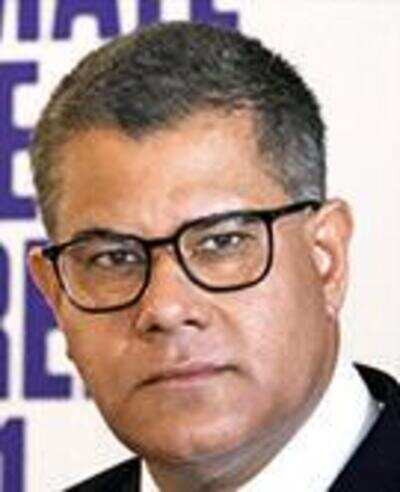- News
- City News
- nagpur News
- ‘Impressed’ COP26 chief wants India to commit to renewables in updated NDC
‘Impressed’ COP26 chief wants India to commit to renewables in updated NDC
‘Impressed’ COP26 chief wants India to commit to renewables in updated NDC

President of the 2021 United Nations Climate Change Conference, COP26, Alok Sharma stated that India has made massive efforts in terms of building out its renewable sector
Nagpur: President of the 26th United Nations Conference of the Parties (COP26) Alok Sharma wants India’s ambitious target of 450 gigawatt (GW) of renewable energy generation by 2030 to reflect in its updated Nationally Determined Contribution (NDC), which “should come forward before the global climate meet.”
The British Member of Parliament (MP), who is the chief of the world’s biggest climate meet which will begin from November 1 in Glasgow, was interacting with journalists across the globe on Tuesday during a virtual press meet organized by Covering Climate Now, an organization of media outlets from across the world.
Various countries have committed to net zero emissions by 2050 and have also submitted their revised NDCs —national climate plans which highlight targets, mitigation measures and policies that governments plan to implement to combat climate change. However, India is yet to make progress in both the fronts.
“Impressed” with the country’s clean energy target, Sharma stated that India has made massive efforts in terms of building out its renewable sector. “Every country starts from a different energy mix. It is evident that the move to renewables is something that India wants to push forward. I hope its NDC also includes the same target,” he added.
The COP chief further highlighted that 80% of the global economy is covered by a net zero target, and almost all of the G20 have now signed up to a net zero commitment by the middle of the century.
Stressing that adaptation and access to finance are going to be the key areas of COP26, Sharma said, “It's disappointing that we weren't able to reach the $100 billion in 2020. But I think with latest delivery plans in place alongside the very rigorous report from the Organisation for Economic Cooperation and Development (OECD), there is confidence that we will reach the target in 2023. And over the five-year period from 2021 to 2025, we will likely be above $500 billion in aggregate.”
According to Sharma, it is clear that developing countries do not want to see adaptation as “a poor cousin of mitigation”.
With COP26 less than a week away, what lies ahead is to reach agreement amongst almost 200 parties. “I think this is going to be in many ways more challenging than Paris. Paris delivered this historic agreement, but it was a framework. We had to do the detailed rules and more work was required on that. Some of those are still outstanding. Overall, what we want is for this COP to deliver. That this can't be a summit, which the general public sees world leaders flying and flying back out. I have been very clear on that right from the start of our presidency,” said Sharma.
The British Member of Parliament (MP), who is the chief of the world’s biggest climate meet which will begin from November 1 in Glasgow, was interacting with journalists across the globe on Tuesday during a virtual press meet organized by Covering Climate Now, an organization of media outlets from across the world.
Various countries have committed to net zero emissions by 2050 and have also submitted their revised NDCs —national climate plans which highlight targets, mitigation measures and policies that governments plan to implement to combat climate change. However, India is yet to make progress in both the fronts.
“Impressed” with the country’s clean energy target, Sharma stated that India has made massive efforts in terms of building out its renewable sector. “Every country starts from a different energy mix. It is evident that the move to renewables is something that India wants to push forward. I hope its NDC also includes the same target,” he added.
The COP chief further highlighted that 80% of the global economy is covered by a net zero target, and almost all of the G20 have now signed up to a net zero commitment by the middle of the century.
Stressing that adaptation and access to finance are going to be the key areas of COP26, Sharma said, “It's disappointing that we weren't able to reach the $100 billion in 2020. But I think with latest delivery plans in place alongside the very rigorous report from the Organisation for Economic Cooperation and Development (OECD), there is confidence that we will reach the target in 2023. And over the five-year period from 2021 to 2025, we will likely be above $500 billion in aggregate.”
According to Sharma, it is clear that developing countries do not want to see adaptation as “a poor cousin of mitigation”.
With COP26 less than a week away, what lies ahead is to reach agreement amongst almost 200 parties. “I think this is going to be in many ways more challenging than Paris. Paris delivered this historic agreement, but it was a framework. We had to do the detailed rules and more work was required on that. Some of those are still outstanding. Overall, what we want is for this COP to deliver. That this can't be a summit, which the general public sees world leaders flying and flying back out. I have been very clear on that right from the start of our presidency,” said Sharma.
FacebookTwitterLinkedinEMail
Start a Conversation
end of article
Quick Links
Delhi Air PollutionDelhi TemperatureChennai WeatherBangalore TemperatureCovid vaccination centres in DelhiCoronavirus in DelhiRTPCR test in GurgaonHyderabad RainPollution level in BangaloreDelhi SmogDelhi TemperatureNoida AQIGurgaon AQI todayFire in MumbaiMumbai RainsCovid 19 RT PCR Test in NoidaDelhi AQI todaySrinagar encounter

